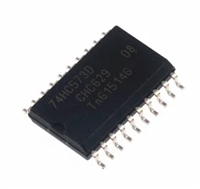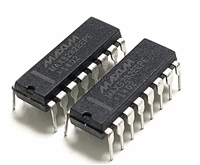AD807
Nominal Center Frequency
DEFINITION OF TERMS
This is the frequency at which the VCO will oscillate with the
loop damping capacitor, CD, shorted.
Maximum, Minimum and Typical Specifications
Specifications for every parameter are derived from statistical
analyses of data taken on multiple devices from multiple wafer
lots. Typical specifications are the mean of the distribution of
the data for that parameter. If a parameter has a maximum (or a
minimum), that value is calculated by adding to (or subtracting
from) the mean six times the standard deviation of the distribution.
This procedure is intended to tolerate production variations: if the
mean shifts by 1.5 standard deviations, the remaining 4.5 standard
deviations still provide a failure rate of only 3.4 parts per million.
For all tested parameters, the test limits are guardbanded to
account for tester variation to thus guarantee that no device is
shipped outside of data sheet specifications.
Tracking Range
This is the range of input data rates over which the AD807 will
remain in lock.
Capture Range
This is the range of input data rates over which the AD807 will
acquire lock.
Static Phase Error
This is the steady-state phase difference, in degrees, between the
recovered clock sampling edge and the optimum sampling instant,
which is assumed to be halfway between the rising and falling
edges of a data bit. Gate delays between the signals that define
static phase error, and IC input and output signals prohibit
direct measurement of static phase error.
Input Sensitivity and Input Overdrive
Sensitivity and Overdrive specifications for the Quantizer involve
offset voltage, gain and noise. The relationship between the logic
output of the quantizer and the analog voltage input is shown in
Figure 1.
Data Transition Density, ρ
This is a measure of the number of data transitions, from “0” to
“1” and from “1” to “0,” over many clock periods. ρ is the ratio
(0 ≤ ρ ≤ 1) of data transitions to bit periods.
For sufficiently large positive input voltage the output is always
Logic 1 and similarly, for negative inputs, the output is always
Logic 0. However, the transitions between output Logic Levels 1
and 0 are not at precisely defined input voltage levels, but occur
over a range of input voltages. Within this Zone of Confusion,
the output may be either 1 or 0, or it may even fail to attain
a valid logic state. The width of this zone is determined by the
input voltage noise of the quantizer (650 µV at the 1 × 10–10
confidence level). The center of the Zone of Confusion is the
quantizer input offset voltage ( 500 µV maximum). Input Over-
drive is the magnitude of signal required to guarantee correct
logic level with 1 × 10–10 confidence level.
Jitter
This is the dynamic displacement of digital signal edges from
their long term average positions, measured in degrees rms or
Unit Intervals (UI). Jitter on the input data can cause dynamic
phase errors on the recovered clock sampling edge. Jitter on the
recovered clock causes jitter on the retimed data.
Output Jitter
This is the jitter on the retimed data, in degrees rms, due to a
specific pattern or some pseudorandom input data sequence
(PRN Sequence).
With a single-ended PIN-TIA (Figure 3), ac coupling is used and
the inputs to the Quantizer are dc biased at some common-mode
potential. Observing the Quantizer input with an oscilloscope
probe at the point indicated shows a binary signal with average
value equal to the common-mode potential and instantaneous
values both above and below the average value. It is convenient
to measure the peak-to-peak amplitude of this signal and call the
minimum required value the Quantizer Sensitivity. Referring to
Figure 1, since both positive and negative offsets need to be
accommodated, the Sensitivity is twice the Overdrive. The AD807
Quantizer has 2 mV Sensitivity.
Jitter Tolerance
Jitter Tolerance is a measure of the AD807’s ability to track a
jittery input data signal. Jitter on the input data is best thought
of as phase modulation, and is usually specified in unit intervals.
The PLL must provide a clock signal that tracks the phase
modulation in order to accurately retime jittered data. In order
for the VCO output to have a phase modulation that tracks the
input jitter, some modulation signal must be generated at the
output of the phase detector. The modulation output from the
phase detector can only be produced by a phase error between
its data input and its clock input. Hence, the PLL can never
perfectly track jittered data. However, the magnitude of the
phase error depends on the gain around the loop. At low fre-
quencies, the integrator of the AD807 PLL provides very high
gain, and thus very large jitter can be tracked with small phase
errors between input data and recovered clock. At frequencies
closer to the loop bandwidth, the gain of the integrator is much
smaller, and thus less input jitter can be tolerated. The AD807
output will have a bit error rate less than 1 × 10–10 when in lock
and retiming input data that has the CCITT G.958 specified
jitter applied to it.
With a differential TIA (Figure 3), Sensitivity seems to improve
from observing the Quantizer input with an oscilloscope probe.
This is an illusion caused by the use of a single-ended probe. A
1 mV peak-to-peak signal appears to drive the AD807 Quantizer.
However, the single-ended probe measures only half the signal.
The true Quantizer input signal is twice this value since the
other Quantizer input is a complementary signal to the sig-
nal being observed.
Response Time
Response time is the delay between removal of the input signal
and indication of Loss of Signal (LOS) at SDOUT. The response
time of the AD807 (1.5 µs maximum) is much faster than the
Jitter Transfer (Refer to Figure 11)
The AD807 exhibits a low-pass filter response to jitter applied to
its input data.
SONET/SDH requirement (3 µs
≤ response time ≤ 100 µs). In
practice, the time constant of the ac coupling at the Quantizer
input determines the LOS response time.
–4–
REV. B






 深入解析AD7606高性能多通道模数转换器:资料手册参数分析
深入解析AD7606高性能多通道模数转换器:资料手册参数分析

 74HC573三态非易失锁存器(Latch)资料手册参数分析
74HC573三态非易失锁存器(Latch)资料手册参数分析

 MAX3232 RS-232电平转换器资料手册参数分析
MAX3232 RS-232电平转换器资料手册参数分析

 MAX485 RS-485/RS-422收发器资料手册参数分析
MAX485 RS-485/RS-422收发器资料手册参数分析
